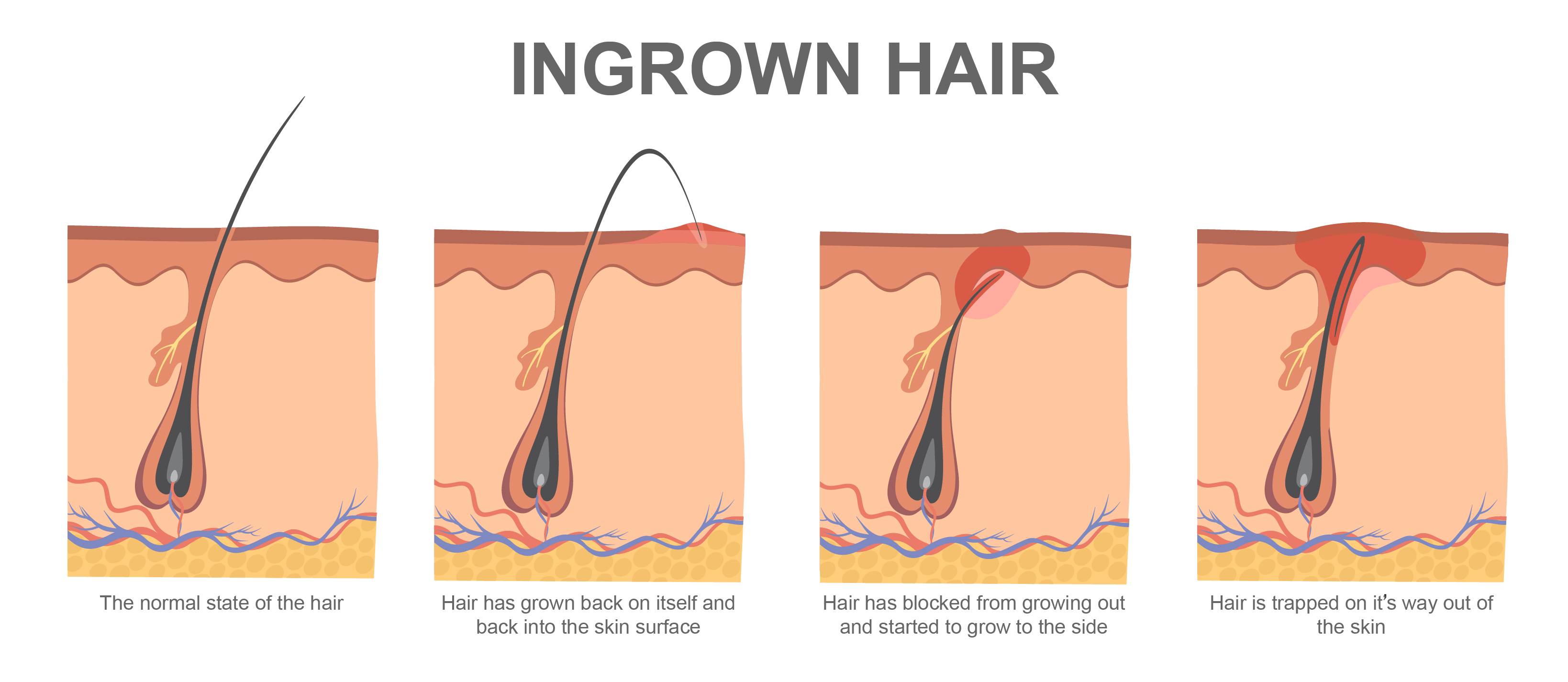Ingrown hairs are a common skin concern that can affect anyone who removes hair through shaving, waxing, or tweezing. These small, often inflamed bumps occur when hair grows back into the skin instead of emerging from the follicle. While they are generally harmless, they can cause discomfort, irritation, and even infection if not managed properly.
What Are Ingrown Hairs?
An ingrown hair occurs when a hair curls back into the skin instead of growing outward. This typically happens when the hair follicle becomes clogged with dead skin cells or the hair grows at an angle, especially in areas with coarse or curly hair. Ingrown hairs can appear as small red or dark bumps, often accompanied by inflammation, itching, or pain. In some cases, they can develop into pus-filled pustules that resemble pimples. While they most commonly occur in areas of frequent hair removal—such as the face, legs, bikini line, and underarms—any hair-bearing part of the body is susceptible.
What Causes Ingrown Hairs?
Hair Removal Techniques
Shaving, waxing, and tweezing are the leading causes of ingrown hairs. Shaving, in particular, creates sharp edges on the hair that make it easier for the hair to pierce the skin as it grows back. Waxing and tweezing, which remove hair from the root, can disrupt the natural growth pattern of hair, increasing the likelihood of it becoming trapped beneath the skin.
Dead Skin Accumulation
Dead skin cells can clog hair follicles, creating a barrier that traps growing hairs under the skin. Without regular exfoliation, this buildup becomes a significant factor in the development of ingrown hairs.
Hair Type and Texture
People with curly or coarse hair are more prone to ingrown hairs. The natural curl of the hair makes it more likely to bend and re-enter the skin, particularly in areas of high friction, such as the bikini line or beard area.
Tight Clothing
Friction from tight clothing, especially in areas like the thighs and underarms, can push hair back into the skin and exacerbate the problem. Loosening your wardrobe during high-risk times, such as immediately after waxing, can significantly reduce this risk.

Are Ingrown Hairs Normal?
Ingrown hairs are entirely normal and common, especially for those who frequently remove hair. However, while they are not usually a medical concern, they can become problematic if they lead to infection or chronic irritation. In individuals with darker skin tones, ingrown hairs can leave behind dark marks (post-inflammatory hyperpigmentation), which may take weeks or months to fade. For some, persistent ingrown hairs can cause scarring or keloids, requiring medical intervention.
How Ingrown Hairs Affect the Skin
Ingrown hairs can have various effects on the skin, including:
- Inflammation: The body identifies the trapped hair as a foreign object, triggering an immune response that results in redness, swelling, and discomfort.
- Acne-like Bumps: Ingrown hairs often look like small pimples and may become pustular if bacteria enter the follicle.
- Dark Spots: Post-inflammatory hyperpigmentation is common, especially in individuals with darker skin tones.
- Scarring: Repeated irritation from ingrown hairs or improper removal techniques can lead to permanent scarring or keloids.

How to Prevent Ingrown Hairs
Prevention is the best strategy for managing ingrown hairs. Simple adjustments to your grooming and skincare routines can make a significant difference.
1. Gentle Exfoliation
Regular exfoliation removes dead skin cells that can clog hair follicles, reducing the likelihood of hairs becoming trapped. Use physical exfoliants like scrubs or tools such as exfoliating gloves. For a gentler approach, opt for chemical exfoliants containing salicylic acid or glycolic acid.
2. Proper Shaving Techniques
Shaving is one of the most common causes of ingrown hairs, but these tips can help minimize risk:
- Shave in the direction of hair growth.
- Use a sharp, clean razor to prevent tugging on the skin.
- Avoid shaving too closely to the skin to prevent sharp edges on the hair.
3. Keep Skin Hydrated
Hydrated skin is more elastic and less likely to trap hairs. Use a moisturizing cream or lotion after exfoliating or shaving to keep the skin supple.
4. Consider Alternative Hair Removal Methods
If shaving, waxing, or tweezing frequently causes ingrown hairs, consider alternative methods such as laser hair removal or depilatory creams. These options can significantly reduce the risk of ingrown hairs by altering hair growth patterns or removing hair entirely.
5. Avoid Tight Clothing
Loose, breathable clothing reduces friction and allows hairs to grow out of the follicle without interference.
How to Treat Ingrown Hairs
At-Home Treatments
If you already have ingrown hairs, here’s how to manage them effectively:
- Exfoliation: Gently exfoliate the area to free the trapped hair and prevent new ones from forming.
- Warm Compress: Soften the skin and encourage the hair to come to the surface by applying a warm, moist compress to the affected area.
- Topical Treatments: Use over-the-counter products containing salicylic acid, glycolic acid, or benzoyl peroxide to reduce inflammation and exfoliate the skin.
Avoid Picking or Squeezing
Resist the temptation to pick at ingrown hairs, as this can introduce bacteria and lead to infection or scarring.
Sterile Removal
If the hair is visible, you can use sterilized tweezers to gently lift it out. Avoid digging into the skin, which can worsen the irritation.
When to Seek Professional Help
For persistent or severe ingrown hairs, consult a dermatologist. A professional may recommend:
- Prescription Retinoids: These increase skin cell turnover and prevent follicle clogging.
- Antibiotics: For infected ingrown hairs, topical or oral antibiotics may be necessary.
- Laser Hair Removal: A long-term solution that reduces hair growth and the likelihood of ingrown hairs.
The Bottom Line
Ingrown hairs are a common but manageable condition. By understanding their causes and adopting preventative measures, you can significantly reduce their occurrence and maintain healthy, irritation-free skin. Whether you’re looking for professional treatment or want personalized advice, reach out to us to keep your skin looking its best. Remember, prevention and proper care are the keys to avoiding the discomfort and frustration of ingrown hairs!
